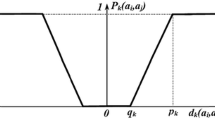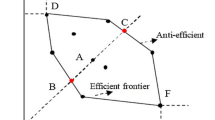Abstract
A hybrid approach of DEA (data envelopment analysis) and TOPSIS (technique for order performance (preference) by similarity to ideal solution) is proposed for multiple criteria decision analysis in emergency management. Two DEA-based optimization models are constructed to facilitate identifying parameter information regarding criterion weights and quantifying qualitative criteria in TOPSIS. An emergency management case study utilizing data from the Emergency Management Australia (EMA) Disasters Database is provided to demonstrate the feasibility of the proposed analysis procedure.
Similar content being viewed by others
References
Abo-Sinna, M.A. & Amer, A.H. (2005). Extensions of TOPSIS for multi-objective large-scale nonlinear programming problems. Applied Mathematics and Computation, 162(1): 243–256
Abo-Sinna, M.A., Amerb, A.H. & Ibrahim, A.S. (2008). Extensions of TOPSIS for large scale multi-objective non-linear programming problems with block angular structure. Applied Mathematical Modelling, 32(3): 292–302
Brennan, G. (1998). The unrepresentative swill feel their oats. Policy, 14: 3–9
Charnes, A., Cooper, W.W. & Rhodes, E. (1978). Measuring efficiency of decisionmaking units. European Journal of Operational Research, 2: 428–449
Chen, C.T. (2000). Extensions of the TOPSIS for group decision-making under environment. Fuzzy Sets and Systems, 114: 1–9
Chen, M.F. & Tzeng, G.H. (2004). Combining gray relation and TOPSIS concepts for selecting an expatriate host country. Mathematical and Computer Modelling, 40: 1473–1490
Chen, Y., Kilgour, D.M. & Hipel, K.W. (2006). Multiple criteria classification with an application in water resources planning. Computers and Operations Research, 33: 3301–3323
Chen, Y., Kilgour, D.M. & Hipel, K.W. (2008a). Multiple criteria sorting method with strategic flexibility. Journal of Industrial and Management Optimization, 4: 407–423
Chen, Y., Li, K.W., Kilgour, D.M. & Hipel, K.W. (2008b). A case-based distance model for multiple criteria ABC analysis. Computers and Operations Research, 35: 776–796
Chen, Y., Su, X. & Hipel, K.W. (2009). An index aggregation approach to comparing the overall performance of emerging and developed countries. Socio-Economic Planning Sciences, 43: 25–39
Cook, W. & Kress, M. (1991). Ordinal Information and Preference Structures: Decision Models and Applications. Prentice-Hall, Englewood Cliffs, NJ
Cook, W. & Kress, M. (1994). A multiple-criterion composite index model for quantitative and qualitative data. European Journal of Operational Research, 78: 367–379
Department of the Environment, Transport and the Regions (DETR). (1998). A New Deal for Trunk Roads in England: Understanding the New Approach to Appraisal. London, UK
Doyle, J. & Green, R. (1994). Efficiency and cross-efficiency in DEA: derivations, meanings and uses. Operational Research Society, 45: 567–578
Doyle, J. (1995). Multiattribute choice for the lazy decision maker: let the alternatives decide! Organizational Behavior and Human Decision Processes, 62: 87–100
Emergency Management Australia (EMA). (2009). Emergency management Australia disasters database. Available via DIALOG. http://www.ema.gov.au. Cited on August 31, 2009
Emrouznejad, A., Parker, B.R. & Tavares, G. (2008). Evaluation of research in efficiency and productivity: a survey and analysis of the first 30 years of scholarly literature in DEA. Socio-Economic Planning Sciences, 42: 151–157
Environmental Protection Agency (EPA). (2009). Databases and tools for emergency management. Available via DIALOG. http://www.epa.gov/oem/tools.htm. Cited on August 31, 2009
Eum, Y.S., Park, K.S. & Soung, S.H. (2001). Establishing dominance and potential optimality in multi-criteria analysis with imprecise weight and value. Computers and Operations Research, 28: 397–409
Figueira, J., Greco, S. & Ehrgott, M. (2005). Multiple Criteria Decision Analysis: State of the Art Surveys. Springer, New York
Fitzpatrick, P.M. (1995). Advanced Calculus: A Course in Mathematical Analysis. Thomson Brooks-Cole, Boston
Haddow, G.D. & Bullock, J.A. (2004). Introduction to Emergency Management. Butterworth-Heinemann, Amsterdam
Hwang, C.L. & Yoon, K. (1981). Multiple Attribute Decision Making. Springer-Verlag, Berlin
Islei, G. & Lockett, A.G. (1988). Judgemental modelling based on geometric least square. European Journal of Operational Research, 36: 27–35
Lai, Y.J., Liu, T.Y. & Hwang, C.L. (1994). TOPSIS for MODM. European Journal of Operational Research, 76: 486–500
Levy, J.K. & Hipel, K.W. (2009). Introduction to the special issue on disaster risk reduction in the post 9–11 security environment. Group Decision and Negotiation, 18: 299–301
Levy, J.K. & Tajib, K. (2007). Group decision support for hazards planning and emergency management: A group analytic network process (GANP) approach. Mathematical and Computer Modelling, 46: 906–917
Li, K.W., Levy, J.K. & Buckley, P. (2009). Enhancing national security and energy security in the post-911 era: group decision support for strategic policy analysis under conditions of conflict. Group Decision and Negotiation, 18: 369–386
Liberatore, M.J. & Nydick, R.L. (2008). The analytic hierarchy process in medical and health care decision making: A literature review. European Journal of Operational Research, 189: 194–207
LINDO Systems. Inc. (Lindo). (2009). Lingo software. Available via DIALOG. http://www.lindo.com. Cited on August 31, 2009
Ng, W.L. (2007). A simple classifier for multiple criteria ABC analysis. European Journal of Operational Research, 177: 344–353
Keeney, R.L. & Raiffa, H. (1976). Decisions with Multiple Objectives: Preferences and Value Tradeoffs. Wiley, New York
Kim, G., Park, C.S. & Yoon, K.P. (1997). Identifying investment opportunities for advanced manufacturing systems with comparative-integrated performance measurement. International Journal of Production Economics, 50: 23–33
Parliament of Australia (PA). (2009). Available via DIALOG. http://www.aph. gov.au. Cited on August 31, 2009
Public Safety Canada (PSC). (2009). Canadian disaster database. Available via DIALOG. http://www.publicsafety.gc.ca/res/em/cdd/index-en.asp. Cited on August 31, 2009
Ramanathan, R. (2006). Data envelopment analysis for weight derivation and aggregation in the analytic hierarchy process. Computers and Operations Research, 33: 1289–1307
Roy, B. (1996). Multicriteria Methodology for Decision Aiding. Kluwer, Dordrecht
Saaty, T.L. (1980). Analytic Hierarchy Process. McGraw Hill, New York
Sage, A.P. & White, C.C. (1984). ARIADNE: a knowledge-based interactive system for planning and decision support. IEEE Transactions on Systems, Man and Cybernetics, 14: 35–47
Sexton, T., Silkman, R. & Hogan, A. (1986). Data envelopment analysis: critique and extensions. In: Silkman, R. (eds.), Measuring Efficiency: an Assessment of Data Envelopment Analysis. Jossey-Bass, San Francisco
Seydel, J. (2006). Data envelopment analysis for decision support. Industrial Management & Data Systems, 106: 81–95
Shih, H.S., Shyur, H.J. & Lee, E.S. (2007). An extension of TOPSIS for group decision making. Mathematical and Computer Modelling, 45: 801–813
Shih, H.S. (2008). Incremental analysis for MCDM with an application to group TOPSIS. European Journal of Operational Research, 186:720–734
Silver, E.A., Pyke, D.F. & Peterson, R. (1998). Inventory Management and Production Planning and Scheduling, 3rd Edition. Wiley, New York
Stewart, T. (1996). Relationships between data envelopment analysis and multicriteria decision analysis. Journal of the Operational Research Society, 47: 654–665
Wang, Y.M. & Chin, K.S. (2009). A new data envelopment analysis method for priority determination and group decision making in the analytic hierarchy process. European Journal of Operational Research, 195: 239–250
Wikipedia. (2009). Emergency management. Available via DIALOG. http://en.wikipedia.org/wiki/Emergencyάn agement. Cited on August 31, 2009
von Winterfeldt, D. & Edwards, W. (1986). Decision Analysis and Befuwioral Research. Cambridge University Press, New York
Author information
Authors and Affiliations
Corresponding author
Additional information
This work was supported by Natural Science Foundation of China under Grant No. 70901040 and 90924022, the Natural Sciences and Engineering Research Council of Canada (NSERC) under its Discovery Grant program, as well as an International & Development Research, Education & Training (IDRET) Seed Monies Grant from the University of Windsor.
Ye Chen is Professor of College of Economics and Management at the Nan**g University of Aeronautics and Astronautics, Nan**g, Jiangsu, China. Previously, he was a post-doctoral Fellow in the Department of Systems Design Engineering at the University of Waterloo, Waterloo, Ontario, Canada, where he received his PhD degree in 2006. His research interests include the development of classification techniques within the field of multiple criteria decision analysis and its applications to water resources, inventory management and elsewhere.Dr. Chen has written papers which have been published in journals including Computers and Operations Research, Decision Support Systems, IEEE Transactions on Systems, Man and Cybernetics, INFOR, OMEGA, Socio-Economic Planning Sciences and Journal of Systems Science and Systems Engineering.
Kevin W. Li received the B.Sc. degree in control sciences and M.A.Sc. degree in systems engineering from **amen University, **amen, China, in 1991 and 1994, respectively, and Ph.D. degree in systems design engineering from the University of Waterloo, Waterloo, Canada in 2003. Dr. Li is currently an associate professor in the Odette School of Business at the University of Windsor, Windsor, Canada. His research interests are concerned with finding equitable and sustainable solutions to complex decision problems at strategic and operational levels. His papers have been published in reputable journals such as Computers and Operations Research, European Journal of Operational Research, IEEE Transactions on Fuzzy Systems, IEEE Transactions on Systems, Man, and Cybernetics, Part A, International Journal of Production Economics, Journal of the Operational Research Society, and Water Resources Research. His research has been supported by a Natural Sciences and Engineering Research Council of Canada (NSERC) individual Discovery Grant and a number of internal grants at the University of Windsor.Dr. Li is a Senior Member of the IEEE and an active member of the Technical Committee on Conflict Resolution of the IEEE Systems, Man, and Cybernetics Society.
Haiyan Xu received the B.A.Sc. degree in Pure Mathematics from Nan**g University, Nan**g, China, the M.Sc. degree in Combinatorics and Optimization from the University of Waterloo, and the PhD degree in systems design engineering from the University of Waterloo, Waterloo, Canada. From 1999 to 2002, she was an Associate Professor in the Faculty of Science of Nan**g University of Aeronautics and Astronautics. She is currently a Postdoctoral Fellow in Systems Design Engineering at the University of Waterloo. Her research interests include conflict analysis, decision making, and mathematical modelling with applications in engineering. Her papers have been published in journals including IEEE Transactions on Systems, Man and Cybernetics, Discrete Applied Mathematics, Applied Mathematics and Computation, and Theory and Decision.
Sifeng Liu is a Distinguished Professor of College Economics and Management, Nan**g University of Aeronautics and Astronautics and the founding president of the Institute for Grey Systems Studies, the president of the Grey Systems Society of China, the Chair of IEEE Technical Committee on Grey Systems.Dr. Liu’s main scientific research activities are in grey systems theory and econometrics. He has directed projects of national, provincial or ministry level and international co-operation projects more than 50, published over 180 research papers and 16 works. Over the years, he has been awarded 12 provincial and national prizes for his outstanding achievements in scientific research and applications and selected as a scholar and expert with outstanding contributions of China, a distinguished professor of China.
Rights and permissions
About this article
Cite this article
Chen, Y., Li, K.W., Xu, H. et al. A DEA-TOPSIS method for multiple criteria decision analysis in emergency management. J. Syst. Sci. Syst. Eng. 18, 489–507 (2009). https://doi.org/10.1007/s11518-009-5120-3
Published:
Issue Date:
DOI: https://doi.org/10.1007/s11518-009-5120-3




